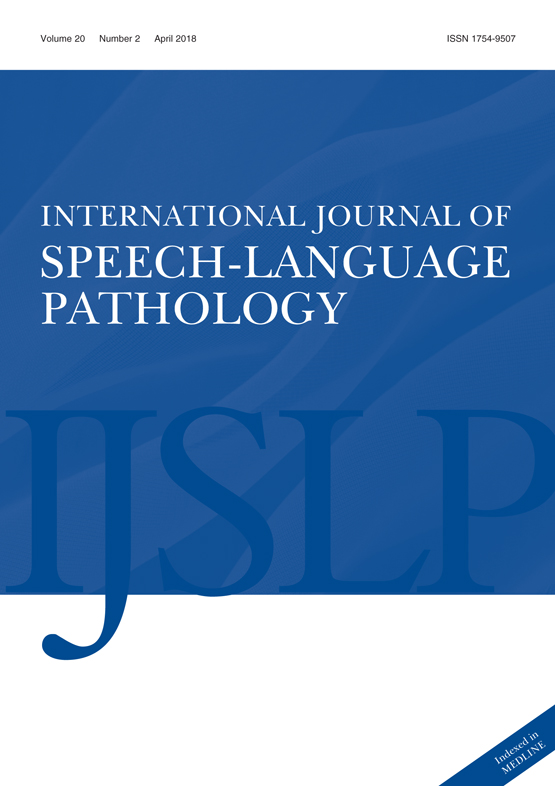【限时资源,期刊全文】International Journal of Speech-Language Pathology(《国际言语病理学杂志》)2019年论文集(侵删)
1862 阅读 16 下载 2020-06-24 14:29:38 上传 29.48 MB
本篇推送的是SSCI期刊International Journal of Speech-Language Pathology(《国际言语病理学杂志》)2019年第21卷第1-6期的63篇论文,。其中目录可在正文中查看,全文可以点击文末附件列表下载,下载链接
International Journal of Speech-Language Pathology(《国际言语病理学杂志》)
2019年第21卷第1-6期的63篇论文
资料整理:张明辉
(资源限时,下载链接即日起三天内有效)

| 卷号 | 期号 | 论文号 | 论文题目 |
| Vol. 21 | Issue 1 | Article 01 | Quality and readability of English-language internet information for aphasia |
| Vol. 21 | Issue 1 | Article 02 | Predictors of receptive and expressive vocabulary development in children with Down syndrome |
| Vol. 21 | Issue 1 | Article 03 | The development and feasibility of an online aphasia group intervention and networking program – TeleGAIN |
| Vol. 21 | Issue 1 | Article 04 | Vocal function exercises for normal voice: The effects of varying dosage |
| Vol. 21 | Issue 1 | Article 05 | Assessing and developing the written reflective practice skills of speech-language pathology students |
| Vol. 21 | Issue 1 | Article 06 | Reference values of maximum performance tests of speech production |
| Vol. 21 | Issue 1 | Article 07 | Implementation of an extended scope of practice speech-language pathology allied health practitioner service: An evaluation of service impacts and outcomes |
| Vol. 21 | Issue 1 | Article 08 | The impact of speech and language problems in kindergarten on academic learning and special education status in grade three |
| Vol. 21 | Issue 1 | Article 09 | Expiratory muscle strength training improves swallowing and respiratory outcomes in people with dysphagia: A systematic review |
| Vol. 21 | Issue 1 | Article 10 | The effectiveness of a classroom-based phonological awareness program for 4–5-year-olds |
| Vol. 21 | Issue 2 | Article 11 | Social communication following traumatic brain injury part I: State-of-the-art review of assessment tools |
| Vol. 21 | Issue 2 | Article 12 | Social communication following traumatic brain injury part 2: Identifying effective treatment ingredients |
| Vol. 21 | Issue 2 | Article 13 | Identifying risk for language impairment in children from linguistically diverse low-income schools |
| Vol. 21 | Issue 2 | Article 14 | Is the speech-language pathology profession prepared for an ageing population? An Australian survey |
| Vol. 21 | Issue 2 | Article 15 | The effect of speech-language pathology students on clinician time use and activity |
| Vol. 21 | Issue 2 | Article 16 | Vocal function exercises for normal voice: With and without semi-occlusion |
| Vol. 21 | Issue 2 | Article 17 | Effects of transcranial direct current stimulation over the Broca’s area on tongue twister production |
| Vol. 21 | Issue 2 | Article 18 | How important is embeddedness in predicting Australian speech–language pathologists’ intentions to leave their jobs and the profession? |
| Vol. 21 | Issue 2 | Article 19 | Effect of mobile technology featuring visual scene displays and just-in-time programming on communication turns by preadolescent and adolescent beginning communicators |
| Vol. 21 | Issue 2 | Article 20 | Language abilities of Indigenous and non-Indigenous Australian children from low socioeconomic backgrounds in their first year of school |
| Vol. 21 | Issue 3 | Article 21 | INSPIRE: Inspiring practice innovation, research and engagement |
| Vol. 21 | Issue 3 | Article 22 | Elizabeth Usher memorial lecture: Expanding scope of practice - inspiring practice change and raising new considerations |
| Vol. 21 | Issue 3 | Article 23 | Cognitive predictors of sentence comprehension in children with and without developmental language disorder: Implications for assessment and treatment |
| Vol. 21 | Issue 3 | Article 24 | “Big Sister” Wisdom: How might non-Indigenous speech-language pathologists genuinely, and effectively, engage with Indigenous Australia? |
| Vol. 21 | Issue 3 | Article 25 | Aspirations for a website to support families’ active waiting for speech-language pathology |
| Vol. 21 | Issue 3 | Article 26 | Oral literal and inferential narrative comprehension in young typically developing children and children with developmental language disorder |
| Vol. 21 | Issue 3 | Article 27 | Perceived barriers and enablers for implementing water protocols in acute stroke care: A qualitative study using the Theoretical Domains Framework |
| Vol. 21 | Issue 3 | Article 28 | Clinical management of childhood apraxia of speech: A survey of speech-language pathologists in Australia and New Zealand |
| Vol. 21 | Issue 3 | Article 29 | The Wangi (talking) project: A feasibility study of a rehabilitation model for aboriginal people with acquired communication disorders after stroke |
| Vol. 21 | Issue 3 | Article 30 | Global citizenship: Defining capabilities for speech-language pathology |
| Vol. 21 | Issue 4 | Article 31 | Narrative skills in two languages of Mandarin–English bilingual children |
| Vol. 21 | Issue 4 | Article 32 | Sentence stress in children with dysarthria and cerebral palsy |
| Vol. 21 | Issue 4 | Article 33 | An investigation into the relationship between parent satisfaction and child fluency in the Lidcombe Program: Clinic versus telehealth delivery |
| Vol. 21 | Issue 4 | Article 34 | Aphasia and reperfusion therapies in hyper-acute settings: A scoping review |
| Vol. 21 | Issue 4 | Article 35 | Language development in children who stutter: A review of recent research |
| Vol. 21 | Issue 4 | Article 36 | Development, intra- and inter-rater reliability of the New Zealand Secretion Scale (NZSS) |
| Vol. 21 | Issue 4 | Article 37 | Delivering group speech maintenance therapy via telerehabilitation to people with Parkinson’s disease: A pilot study |
| Vol. 21 | Issue 4 | Article 38 | Validation of the Intelligibility in Context Scale for Korean-speaking pre-school children |
| Vol. 21 | Issue 4 | Article 39 | Development of the Mandarin speech banana |
| Vol. 21 | Issue 4 | Article 40 | The feasibility and appropriateness of a peer-to-peer, play-based intervention for improving pragmatic language in children with autism spectrum disorder |
| Vol. 21 | Issue 4 | Article 41 | School-based language screening among primary school children using telepractice: A feasibility study from India |
| Vol. 21 | Issue 5 | Article 42 | ‘Joined-up practice’: Optimising recovery for people with aphasia and their family and friends |
| Vol. 21 | Issue 5 | Article 43 | The seven habits of highly effective aphasia therapists: The perspective of people living with aphasia |
| Vol. 21 | Issue 5 | Article 44 | Optimising recovery in aphasia: Learning following exposure to a single dose of computer-based script training |
| Vol. 21 | Issue 5 | Article 45 | Aphasia and stroke therapeutic alliance measure (A-STAM): Development and preliminary psychometric evaluation |
| Vol. 21 | Issue 5 | Article 46 | Family members’ experiences and preferences for receiving aphasia information during early phases in the continuum of care |
| Vol. 21 | Issue 5 | Article 47 | Lost for words: Perspectives and experiences of people with primary progressive aphasia and Alzheimer’s disease and their families of participation in a lexical retrieval intervention |
| Vol. 21 | Issue 5 | Article 48 | What do speech–language pathologists describe as most important when trying to achieve client participation during aphasia rehabilitation? A qualitative focus group interview study |
| Vol. 21 | Issue 5 | Article 49 | Revisiting the public awareness of aphasia in Exeter: 16 years on |
| Vol. 21 | Issue 5 | Article 50 | The impact of the telerehabilitation group aphasia intervention and networking programme on communication, participation, and quality of life in people with aphasia |
| Vol. 21 | Issue 5 | Article 51 | Representation and reporting of communicatively vulnerable patients in patient experience research |
| Vol. 21 | Issue 6 | Article 52 | An epidemiological profile of communication disability among older adults with complex needs: A national cross-sectional study |
| Vol. 21 | Issue 6 | Article 53 | Clinical profile of primary progressive aphasias in a tertiary care centre from India |
| Vol. 21 | Issue 6 | Article 54 | Development and validation of a speech pathology-specific questionnaire for persons with multiple sclerosis (SMS) |
| Vol. 21 | Issue 6 | Article 55 | Detecting Bulbar Motor Involvement in ALS: Comparing speech and chewing tasks |
| Vol. 21 | Issue 6 | Article 56 | Communication service provision and access for people with Parkinson’s disease in Australia: A national survey of speech-language pathologists |
| Vol. 21 | Issue 6 | Article 57 | The Lombard effect associated with Chinese male alaryngeal speech |
| Vol. 21 | Issue 6 | Article 58 | Predictive value of laryngeal adductor reflex testing in patients with dysphagia due to a cerebral vascular accident |
| Vol. 21 | Issue 6 | Article 59 | Describing language assessments for school-aged children: A Delphi study |
| Vol. 21 | Issue 6 | Article 60 | Identifying developmental language disorder in bilingual children from diverse linguistic backgrounds |
| Vol. 21 | Issue 6 | Article 61 | Prosodic aspects of repetition in Swedish-speaking children with developmental language disorder |
| Vol. 21 | Issue 6 | Article 62 | Enhanced milieu teaching for children with autism spectrum disorder in South Africa |
| Vol. 21 | Issue 6 | Article 63 | Exploring how preschoolers who stutter use spoken language during free play: A feasibility study |
所需积分:0 分
限期开放已结束
表情
图片
附件















